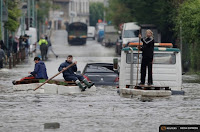When climate scientists examine whether the warming of the Earth has made extreme weather events such as heatwaves or downpours more likely, they generally do it on a case-by-case basis. But a group led by Stanford climate scientist Noah Diffenbaugh has aimed to develop a more global, comprehensive approach to investigating how climate change has impacted such extremes.
With a new framework they developed, Diffenbaugh’s team found that heat records were made both more likely and more severe for about 80 percent of the area of the globe with good observational data. For precipitation records, that percentage was about half.
The team also examined a few particular events, finding, for example, that warming was clearly linked to the record-low summer Arctic sea ice extent of 2012.
Given the findings of previous so-called attribution studies as well as long-term warming trends, those results aren’t surprising, but they do show how much human-caused global warming has affected weather extremes already, the study authors and outside experts said.
And while several outside researchers quibbled with some aspects of the study, they said it provided a new tool that could help researchers more easily and uniformly probe what ingredients of a particular extreme event exhibit a climate change signal.
“The overall message — that changes in extremes worldwide can be attributed to human-induced climate change — is not new, but this paper adds another piece of relevant evidence to bolster that conclusion,” Peter Stott, a UK Met Office climatologist who conducted the 2003 study that kicked off the attribution sub-field, said in an email.
The idea behind extreme event attribution studies is to gain a better handle on how warming is changing the risk of different types of extreme weather in different areas. Because extremes have some of the biggest impacts on people, infrastructure and the economy, understanding how those risks are changing can help government officials and businesses better plan for the future.
Most of these studies, though, are generally case studies of specific events, often ones that happen in scientists’ backyards. While informative, they lead to what scientists call “selection bias,” meaning they aren’t taking in the full scope of how warming is affecting extreme weather.
Diffenbaugh and his colleagues, who have done several attribution case studies, particularly on the California drought, sought to get a broader view by using existing attribution methods to look at particular climate measures across a broader swath of the planet. These included the hottest day, hottest month, driest year and the wettest five-day period.
The results, detailed Monday in the journal Proceedings of the National Academy of Sciences, show that heat records in 80 percent of the study area were more likely affected by climate change than not, Diffenbaugh said.
This suggests that the world is not quite at the point where every single record-setting heat event has a discernable climate change influence, “but we are getting close,” he said.
Read more at The Fingerprints of Global Warming on Extreme Weather

No comments:
Post a Comment